Why Are Some Parrot Species More Endangered Than Others?
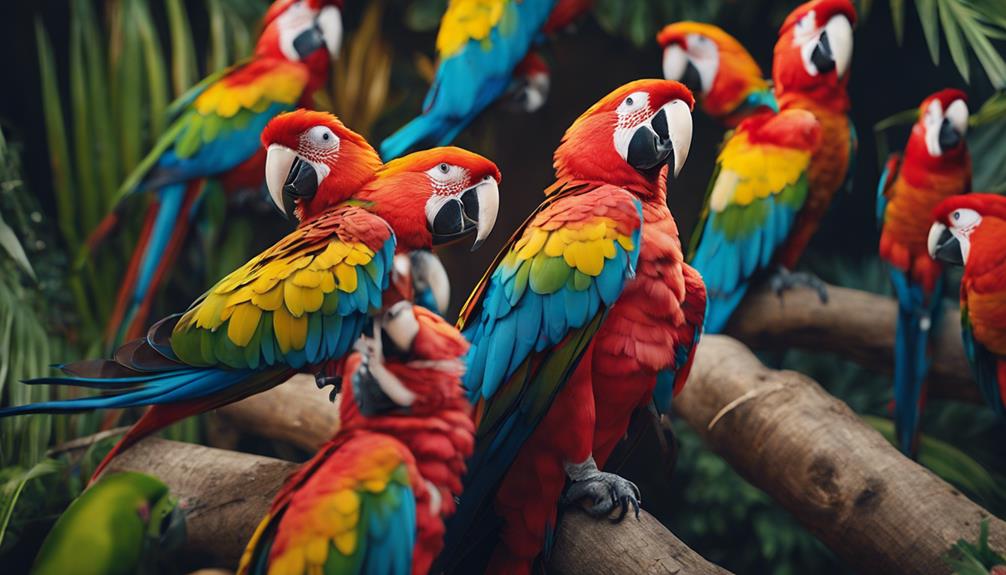
Factors such as habitat loss, illegal wildlife trade, and climate change contribute to the varying levels of endangerment among parrot species.
Understanding and addressing these threats are essential for protecting these colorful birds from extinction.
Habitat Loss
Habitat loss poses a significant threat to the survival of endangered parrot species worldwide. The impact of habitat loss on parrots is profound, as these birds heavily rely on specific habitats for nesting, feeding, and breeding. When their natural habitats are destroyed or fragmented due to activities such as deforestation, urbanization, and agriculture, parrot populations suffer immensely. This disruption leads to decreased food sources, limited breeding grounds, and increased vulnerability to predators, ultimately endangering the survival of these already fragile species.
Conservation efforts play a crucial role in mitigating the effects of habitat loss on endangered parrot species. Organizations and governments worldwide are actively involved in creating and managing protected areas, implementing reforestation projects, and promoting sustainable land use practices to preserve crucial parrot habitats. Additionally, raising awareness about the importance of conserving these habitats and engaging local communities in conservation initiatives are essential steps in safeguarding the future of endangered parrot species. Through collaborative conservation efforts, there's hope for reversing the detrimental impact of habitat loss on these magnificent birds.
Illegal Wildlife Trade
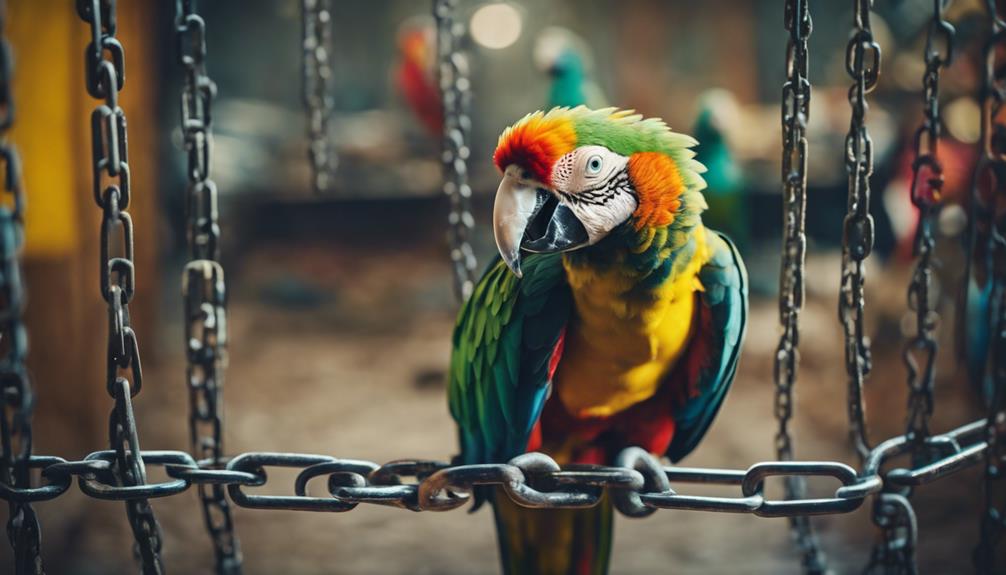
The illegal wildlife trade poses a grave threat to the well-being and survival of endangered parrot species worldwide. This illicit activity fuels the decline in parrot populations by capturing and selling these birds for profit.
To address this issue effectively, the following strategies are crucial:
- Demand Reduction: Implementing campaigns to reduce the demand for exotic pets can significantly decrease the incentive for poachers and traffickers to target parrot species.
- Conservation Awareness: Educating local communities about the importance of protecting parrots in their natural habitats can foster a sense of stewardship and discourage participation in the illegal wildlife trade.
- Law Enforcement: Strengthening law enforcement efforts to combat wildlife trafficking is essential in disrupting the networks that exploit and trade endangered parrots.
- Trafficking Routes: Identifying and monitoring the key trafficking routes used to smuggle parrots can aid in intercepting illegal shipments and dismantling smuggling operations, thereby protecting vulnerable parrot species from further harm.
Climate Change Impact
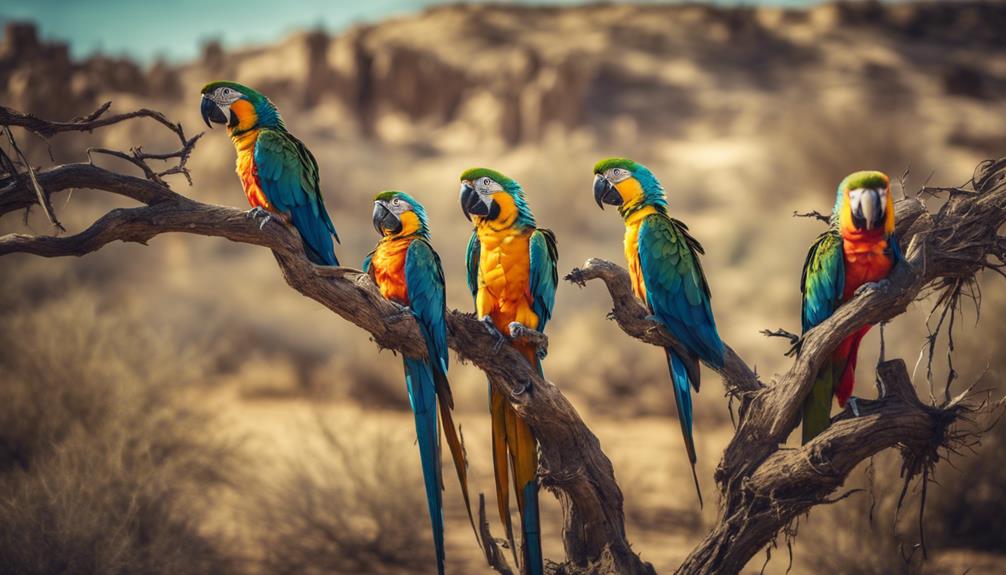
Amidst the challenges posed by the illegal wildlife trade, the impact of climate change on endangered parrot species emerges as a pressing concern, influencing their habitats and survival prospects. Climate change affects parrot species through alterations in temperature, precipitation patterns, and the availability of food sources. These changes can lead to habitat loss, fragmentation, and increased frequency of extreme weather events, all of which threaten the survival of already endangered parrot populations.
| Climate Change Impact on Endangered Parrot Species | |
|---|---|
| 1. Habitat Loss | 3. Increased Frequency of Extreme Weather Events |
| 2. Fragmentation of Habitats | 4. Altered Availability of Food Sources |
| 5. Disruption of Breeding Patterns |
Conservation efforts must address these climate-related challenges to safeguard the future of endangered parrot species. Implementing breeding programs, habitat conservation initiatives, and rehabilitation projects that consider the impacts of climate change are crucial for ensuring the long-term survival and well-being of these magnificent birds. By integrating climate change adaptation strategies into conservation practices, we can work towards mitigating the threats posed by a rapidly changing environment and secure a better future for endangered parrot species.
Disease Outbreaks
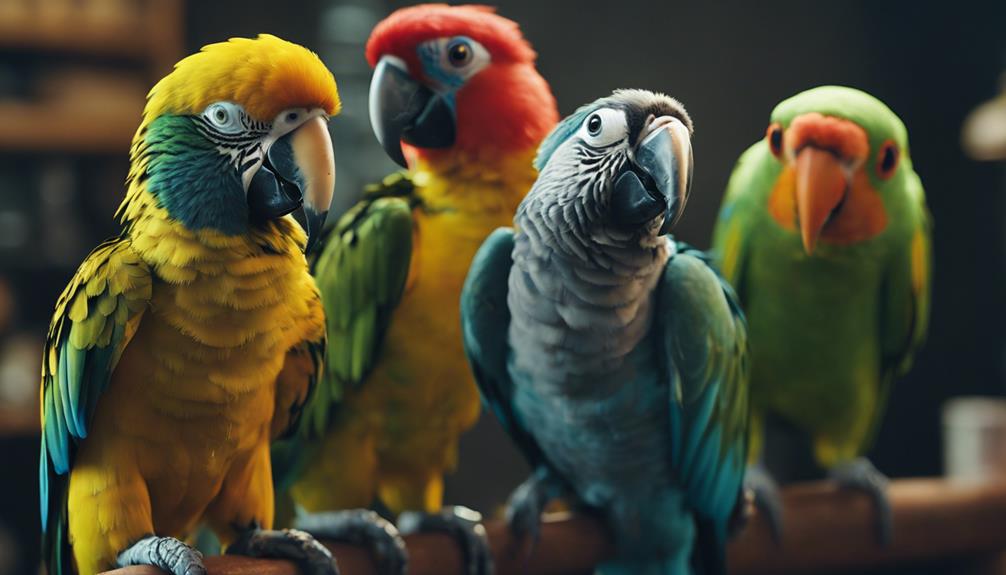
Disease outbreaks are a significant concern for endangered parrot species, as they can decimate populations and hinder conservation efforts. Understanding the impact of avian diseases on these vulnerable birds is crucial for implementing effective disease prevention strategies.
Impact of Avian Diseases
With the rise in global trade and increased interaction between wild and domestic bird populations, avian diseases have become a significant concern for the conservation of endangered parrot species. Avian diseases can have devastating effects on already vulnerable populations, further threatening their survival. Understanding the impact of these diseases is crucial for implementing effective conservation strategies.
- Transmission Routes: Avian diseases can spread through various pathways, including direct contact between birds, contaminated food or water sources, and vectors like mosquitoes.
- Population Immunity: Endangered parrot species with small population sizes may have limited genetic diversity, making them more susceptible to diseases and less able to develop immunity.
- Disease Surveillance: Regular monitoring for avian diseases is essential to detect outbreaks early and implement rapid response measures to prevent widespread infections.
- Habitat Management: Creating and maintaining healthy habitats can help reduce stress on parrot populations, making them more resilient to disease outbreaks.
Disease Prevention Strategies
In light of the increasing threat posed by avian diseases to endangered parrot species, implementing proactive disease prevention strategies is paramount for safeguarding their populations against potential disease outbreaks.
Vaccination programs play a crucial role in protecting parrots from deadly diseases like Psittacine Beak and Feather Disease. Additionally, stringent biosecurity measures can help prevent the introduction and spread of pathogens within parrot populations.
Quarantine protocols are essential for isolating new arrivals and monitoring their health status before introducing them to existing flocks. Disease surveillance through regular monitoring and testing can aid in early detection and containment of potential outbreaks.
Limited Geographic Range
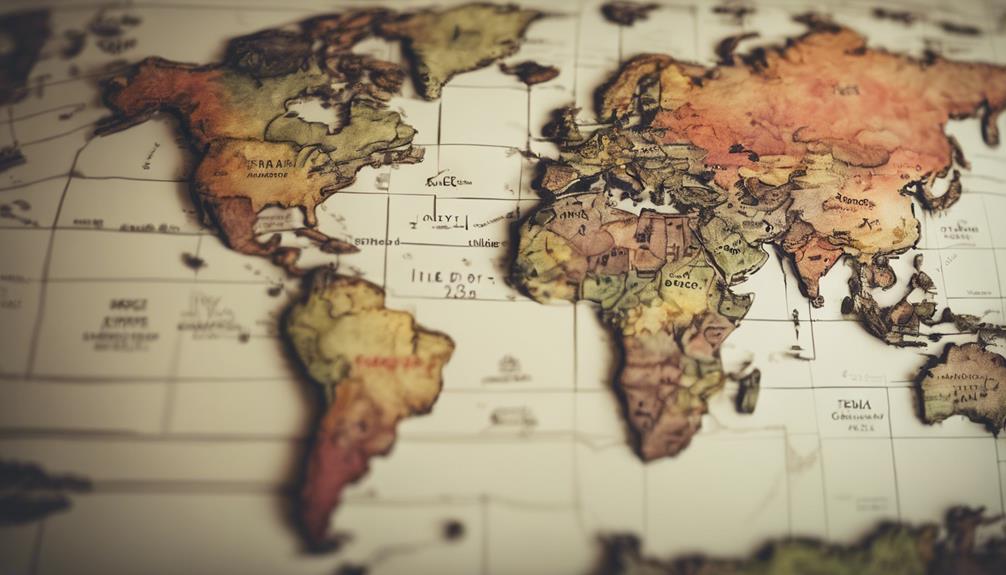
Limited geographic range is a critical factor contributing to the vulnerability of endangered parrot species. Habitat fragmentation due to human activities such as deforestation isolates populations, leading to decreased genetic diversity and increased susceptibility to environmental changes.
The impact of climate change further exacerbates this issue by altering suitable habitats and food sources, pushing these parrot species towards endangerment.
Habitat Fragmentation
Fragmented habitats pose a significant threat to endangered parrot species by restricting their geographic range and limiting their ability to find suitable nesting and foraging sites. These challenges are exacerbated by various factors:
- Isolation: Fragmented habitats can isolate parrot populations, leading to reduced genetic diversity and potentially increasing their vulnerability to diseases and environmental changes.
- Competition: Limited space within fragmented habitats can intensify competition among parrot species for resources, further endangering those already at risk.
- Predation: Fragmentation can expose parrots to increased predation risks as they may lack the necessary cover or resources to escape predators.
- Disruption of Behavior: Habitat fragmentation can disrupt natural behaviors such as breeding, feeding, and migration patterns, impacting the overall survival of endangered parrot species.
Climate Change Impact
Despite the challenges posed by climate change, endangered parrot species face a critical threat due to their restricted geographic range, which exacerbates their vulnerability to environmental shifts.
Parrot species with limited ranges are at higher risk of extinction as they're more susceptible to habitat loss and alterations caused by climate change. Conservation efforts focusing on breeding programs and captive breeding play a crucial role in safeguarding these vulnerable species.
By establishing captive breeding programs, conservationists can help increase the population size of endangered parrots and reduce the impact of climate change on wild populations.
Additionally, habitat restoration projects are essential to provide suitable environments for parrots to thrive, supporting their adaptation to changing climatic conditions and ensuring their long-term survival.
Illegal Wildlife Trade
The illegal wildlife trade poses a severe threat to endangered parrot species with restricted geographic ranges, compounding the challenges they already face from habitat loss and climate change. This illicit activity significantly impacts these vulnerable species through poaching and smuggling.
To address this issue effectively, conservation efforts should focus on:
- Enhancing Enforcement: Strengthening anti-poaching measures to combat illegal wildlife trafficking.
- Increasing Awareness: Educating local communities about the consequences of wildlife trafficking on endangered parrot populations.
- Supporting Legislation: Advocating for stricter laws and penalties to deter wildlife criminals.
- Promoting Sustainable Practices: Encouraging sustainable alternatives to reduce the demand for illegally traded parrots.
Predation and Competition
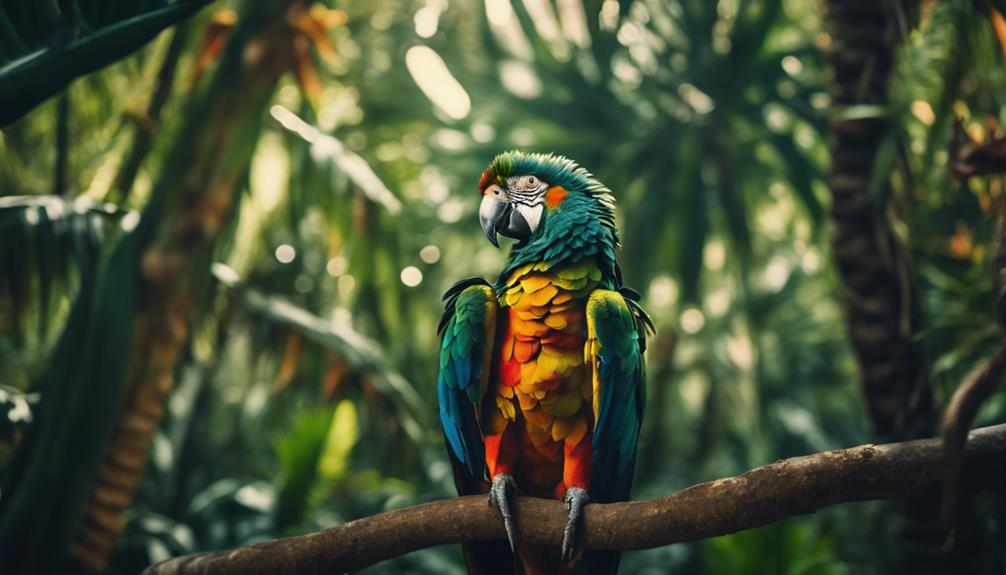
Predation and competition significantly impact the survival prospects of endangered parrot species in their natural habitats. Nesting habits play a crucial role in this aspect, as parrots vulnerable to predation often face challenges in finding safe and suitable nesting sites. Species with specific nesting requirements, like tree cavities or cliffs, are particularly susceptible to predation by animals such as snakes, rats, and other birds.
Additionally, competition for food sources can further exacerbate the vulnerability of endangered parrots. When food is scarce, parrot populations may decline due to inadequate nutrition, leading to weakened immune systems and reduced reproductive success. Furthermore, invasive species introduced by human activities can outcompete native parrots for food, further impacting their survival.
Understanding the intricate balance between predation, competition, nesting habits, and food availability is crucial for developing effective conservation strategies to protect endangered parrot species from further decline.
Lack of Conservation Efforts
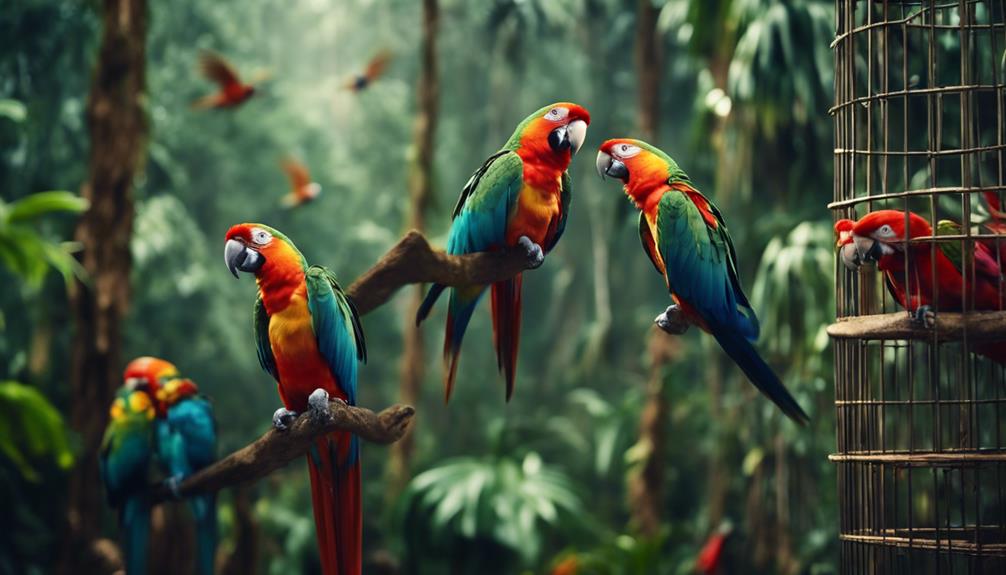
Given the critical role that predation and competition play in the survival of endangered parrot species, the lack of conservation efforts poses a significant threat to their long-term viability in the wild. This lack of action stems from various factors, including:
- Lack of Funding: Insufficient financial resources hinder conservation projects aimed at protecting endangered parrot species. Without adequate funding, initiatives such as habitat preservation, anti-poaching measures, and captive breeding programs struggle to make a meaningful impact.
- Lack of Awareness: Many people remain unaware of the plight facing endangered parrot species. Without widespread knowledge and understanding of the threats these birds face, there's a limited sense of urgency to take action to conserve them.
- Limited Government Support: In some regions, governmental support for conservation efforts targeting endangered parrots is lacking. This lack of official backing can impede the implementation of effective conservation strategies.
- Resource Allocation Challenges: Competing conservation priorities and limited resources within the conservation community can divert attention and funding away from endangered parrot species, further exacerbating the lack of conservation efforts.
Frequently Asked Questions
What Role Do Human Activities Play in the Endangerment of Parrot Species?
Human activities significantly contribute to the endangerment of parrot species. Habitat destruction, climate change, illegal trade, and pollution all play a role. These factors disrupt ecosystems, reduce food sources, and directly harm parrot populations, leading to their decline.
How Do Parrot Species Adapt to Changing Environmental Conditions?
Parrot species exhibit diverse adaptive behaviors to cope with changing environmental conditions. Their climate resilience varies based on factors like habitat loss and fragmentation. Understanding these traits can aid in conservation efforts for vulnerable populations.
Are There Specific Genetic Factors That Make Some Parrot Species More Vulnerable to Extinction?
Genetic diversity plays a crucial role in determining a species' resilience to environmental threats. Habitat loss can disproportionately impact parrot species with limited genetic variability, making them more vulnerable to extinction, like a fragile thread unraveling.
How Do Parrot Species Communicate and Interact With Other Wildlife in Their Ecosystems?
Parrot species communicate through vocal mimicry, establishing social hierarchies. They interact with wildlife through foraging behaviors and predator evasion strategies. Understanding these dynamics is crucial for conserving their ecosystems and promoting biodiversity.
What Are the Potential Long-Term Effects of Losing Parrot Species on Their Respective Ecosystems?
In the intricate web of ecosystem dynamics, losing parrot species could have profound long-term effects. Biodiversity impact may disrupt natural balances, emphasizing the urgency of conservation efforts and habitat restoration to safeguard these vibrant creatures and their habitats.











